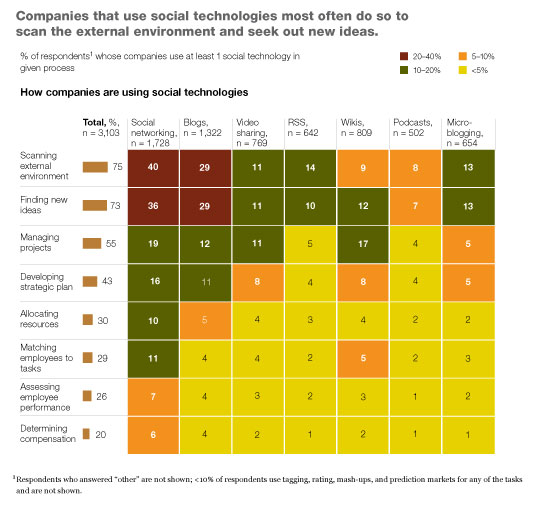Open innovation isn’t a new phenomenon. The first Oxford English Dictionary was an open-source project: editors solicited the participation of hundreds of amateur volunteer readers. Fascinating examples of information sharing and innovative intellectual-property arrangements can also be found in the evolution of Cornish pumping engines in the 18th century and of blast furnaces in northern England during the 19th century. Software itself was distributed free of charge during the 1950s.1
But open innovation has been gathering force in recent years, thanks to the emergence of the Internet as a global information-sharing network; the increasing importance of digitizable, knowledge-based products and services; and the sheer volume of data being generated, processed, and stored by a wide range of enterprises. From a beachhead in software (see companion article, “Managing the business risks of open innovation”), open innovation has spread to a range of industries that use external insights to boost internal R&D efforts or even rely on outside networks for core product ideas. Our latest research on Web 2.0 technologies reveals that more and more executives are taking advantage of these opportunities and foresee the need for organizational change if their companies are to compete in a more open, networked environment.
Porous company borders increase participation . . .
We have found that nearly two-thirds of the companies around the world that adopt a social-technology platform aim to collaborate beyond their own walls to share ideas and information with customers and suppliers. We call this organizational form the “networked enterprise.” The rising ability to connect creates a large, vibrant pool of participants: as many as 30 percent of Internet users say they would actively innovate using social technologies.2 Within this broader group are significant numbers of people, such as software developers and product designers, who make the most valuable contributions. The large number of open projects continues to grow rapidly at organizations such as the T-shirt company Threadless (which uses its customers’ design ideas to help create its apparel lines) and InnoCentive (a “crowd-sourcing” network that companies in the pharmaceutical and other industries use to solve difficult problems).3 Our survey research suggests that the prospects for open innovation will only improve, as many executives expect a further blurring of boundaries between employees and people outside the enterprise (Exhibit 1).

. . . improve the flow of product ideas . . .
The two most important uses of social technologies, we found, are to underpin the processes companies use in scanning the external environment and to help them seek out new ideas (Exhibit 2), with social networks and blogs being the most widely deployed tools. We also found that the more extensively a company is networked, the more likely it is to use the Internet for these purposes. That’s important for open innovation because the knowledge economy has created increasingly virtual products and services—from software to product designs—that can easily be shared and amended by online communities. Research shows that consumers are more likely to find value in products they had a hand in creating, a trend reinforced by the way new digital platforms are improving the economics of product versioning and bundling. Customized, complementary products and services can therefore be created by the “crowd” and widely distributed, often subsidizing core product offerings.

. . . and lift returns on R&D
For many companies, the return on R&D spending has steadily declined as the cost of renewing high-quality product portfolios has mounted. Some companies have turned to open-source strategies to address this problem. One well-known example is Procter & Gamble, which has leveraged its R&D spending through an innovation network that taps the creativity and experience of more than 100,000 customers, former employees, and outside experts. P&G is far from alone. Our research shows that companies whose borders are open to creative engagement with suppliers, partners, and customers can reap significant benefits. In particular, the application of Internet technologies to scan external environments and seek outside ideas correlates statistically with market share improvements.4
Organizational change to catalyze contributions
While the number of open-source projects is growing rapidly, research has shown that about 90 percent of them don’t fully achieve their potential. Leaders will need to know how the innovation landscape is evolving and be ready to respond by following some basic tenets.
Start at the grass roots. Our survey research indicates that nearly half of the early adopters of collaborative technologies promoted their use by mobilizing people on lower levels of the organization. Hierarchal, top-down controls rarely succeed, since most creative interactions are tacit and dynamic.
Develop competencies at the edge. Companies best leverage social and knowledge networks by venturing beyond corporate boundaries, as P&G has done. But opening the gates of the enterprise doesn’t guarantee a robust network—and could compromise valuable intellectual property. Success depends upon the ability to gain the trust of users, transparency, and a deft hand in managing interactions.
Understand what makes participants tick. Users and consumers have different motives for contributing their time and skills. For some, the goal is simply recognition; for others, rewards or revenue sharing may be necessary to induce valuable efforts. Determining what matters for your priority constituencies is crucial.
The world is evolving toward more frequent competition between the open-source and proprietary models for developing products and services. The seemingly tactical organizational issues discussed here should increasingly influence the innovations, intellectual-property approaches, and strategic evolution of a wide variety of enterprises. They deserve a place on senior management’s agenda.


